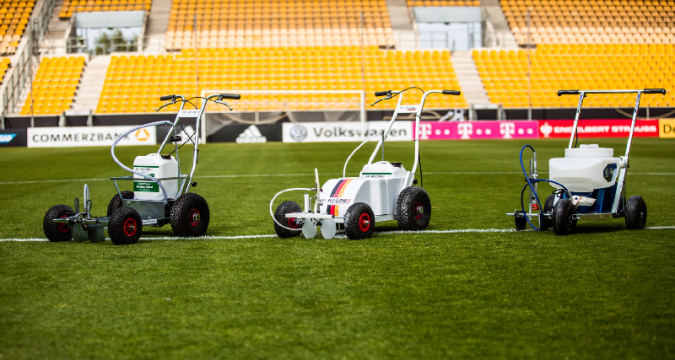
Football stadium maintenance is a complex process that calls for careful attention to detail, thorough planning, and constant work. Every part of the stadium, from the tall stands to the beautiful green lawn, requires specialist maintenance to keep it in excellent shape for every game. This article explores the many facets of maintaining a football stadium, providing advice and best practices for maintaining a venue in immaculate shape.
Turf Maintenance
The turf is arguably the most critical element of a football stadium. It is the playing surface, and its condition directly impacts the game and player safety. Turf maintenance involves several key practices:
- Regular Mowing and Aeration: The grass needs to be mowed regularly to maintain an optimal height, which can vary depending on the specific type of turf used. Aeration, which involves perforating the soil to allow air, water, and nutrients to penetrate the grassroots, is essential to prevent soil compaction and promote healthy growth.
- Irrigation Management: Proper watering is crucial. Overwatering can lead to fungal diseases and a weak root system, while underwatering can cause the turf to dry out and become brittle. An automated irrigation system with moisture sensors can help maintain the right balance.
- Fertilization and Pest Control: Regular fertilization ensures the turf gets the necessary nutrients. A balanced fertilization schedule tailored to the specific needs of the turf will promote healthy growth and resilience. Pest control, including the management of insects and weeds, is equally important to maintain the turf’s health.
- Turf Repair and Replacement: High-traffic areas, such as goalmouths and midfield, often require more frequent repair or replacement. Keeping a stock of sod and having a plan for quick repairs can minimize downtime and ensure a consistent playing surface.
Stadium Structure Maintenance
The physical structure of the stadium, including stands, concourses, and exterior, requires ongoing maintenance to ensure safety and aesthetics.
- Regular Inspections: Conducting regular inspections of the stadium’s structural components is crucial. This includes checking for any signs of wear and tear, such as cracks, rust, or water damage.
- Cleaning and Upkeep: Keeping the stadium clean is a never-ending task. This includes not just the stands, but also the restrooms, concession areas, and walkways. Regular cleaning helps maintain a pleasant environment for fans and can prevent the buildup of grime that can cause long-term damage.
- Painting and Surface Treatment: To protect against the elements, painting and other surface treatments should be applied regularly. This includes repainting lines on the field, as well as treating metal surfaces to prevent rust and corrosion.
- Electrical and Plumbing Maintenance: The stadium’s electrical systems, including lighting for night games, scoreboards, and public address systems, require regular checks and maintenance. Similarly, plumbing systems, from restrooms to concessions, must be regularly serviced to avoid disruptions.
Seating and Fan Experience
The comfort and safety of the fans are paramount. Maintaining seating and ensuring an enjoyable experience is essential for a successful stadium.
- Seating Inspection and Repair: Seats should be inspected regularly for any damage or wear. Broken seats not only reduce the stadium’s capacity but can also pose safety hazards. Regular repairs and replacements are necessary to maintain seating quality.
- Cleanliness and Hygiene: Cleanliness in restrooms, food courts, and other common areas significantly affects the fan experience. Regular cleaning schedules and immediate response to spills or messes can help maintain high hygiene standards.
- Accessibility and Safety: Ensuring that the stadium is accessible to all fans, including those with disabilities, is crucial. Regularly checking ramps, elevators, and accessible seating areas is part of this process. Additionally, safety measures such as clearly marked exits, functional emergency lighting, and regular drills for staff are essential for fan safety.
Technology and Innovation
Incorporating technology can greatly enhance maintenance efficiency and the overall stadium experience.
- Smart Irrigation Systems: Utilizing smart irrigation systems with real-time moisture sensors can optimize water usage and ensure the turf remains in perfect condition.
- Digital Ticketing and Access Control: Implementing digital ticketing systems can streamline fan entry and reduce the strain on entry points, making crowd management easier.
- Maintenance Management Software: Using software to track maintenance schedules, repairs, and inspections can ensure that no aspect of stadium upkeep is overlooked. These systems can send reminders for upcoming maintenance tasks and keep a record of completed work.
- Sustainability Initiatives: Incorporating green technologies such as solar panels, LED lighting, and recycling programs can not only reduce operational costs but also enhance the stadium’s reputation as an environmentally friendly venue.
Maintaining a football stadium is a complex, ongoing process that requires a comprehensive approach. By focusing on turf care, structural integrity, fan experience, and technological advancements, stadium managers can ensure their facilities remain in top condition. A well-maintained stadium not only provides a safe and enjoyable environment for players and fans but also stands as a proud symbol of the sport. Investing in regular, meticulous maintenance is crucial for the long-term success and sustainability of any football stadium.